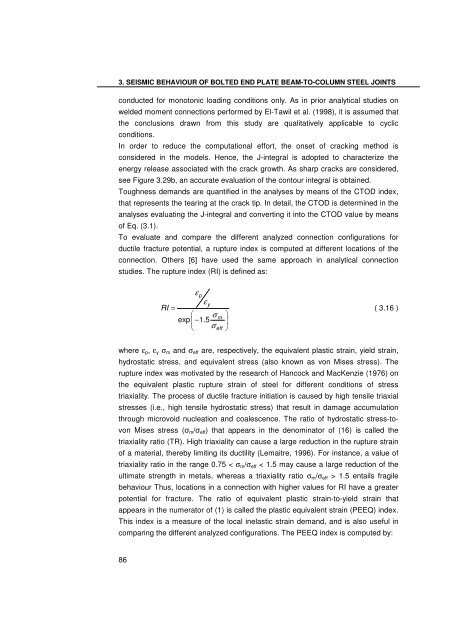Analysis and modelling of the seismic behaviour of high ... - Ingegneria
Analysis and modelling of the seismic behaviour of high ... - Ingegneria
Analysis and modelling of the seismic behaviour of high ... - Ingegneria
Create successful ePaper yourself
Turn your PDF publications into a flip-book with our unique Google optimized e-Paper software.
3. SEISMIC BEHAVIOUR OF BOLTED END PLATE BEAM-TO-COLUMN STEEL JOINTS<br />
conducted for monotonic loading conditions only. As in prior analytical studies on<br />
welded moment connections performed by El-Tawil et al. (1998), it is assumed that<br />
<strong>the</strong> conclusions drawn from this study are qualitatively applicable to cyclic<br />
conditions.<br />
In order to reduce <strong>the</strong> computational effort, <strong>the</strong> onset <strong>of</strong> cracking method is<br />
considered in <strong>the</strong> models. Hence, <strong>the</strong> J-integral is adopted to characterize <strong>the</strong><br />
energy release associated with <strong>the</strong> crack growth. As sharp cracks are considered,<br />
see Figure 3.29b, an accurate evaluation <strong>of</strong> <strong>the</strong> contour integral is obtained.<br />
Toughness dem<strong>and</strong>s are quantified in <strong>the</strong> analyses by means <strong>of</strong> <strong>the</strong> CTOD index,<br />
that represents <strong>the</strong> tearing at <strong>the</strong> crack tip. In detail, <strong>the</strong> CTOD is determined in <strong>the</strong><br />
analyses evaluating <strong>the</strong> J-integral <strong>and</strong> converting it into <strong>the</strong> CTOD value by means<br />
<strong>of</strong> Eq. (3.1).<br />
To evaluate <strong>and</strong> compare <strong>the</strong> different analyzed connection configurations for<br />
ductile fracture potential, a rupture index is computed at different locations <strong>of</strong> <strong>the</strong><br />
connection. O<strong>the</strong>rs [6] have used <strong>the</strong> same approach in analytical connection<br />
studies. The rupture index (RI) is defined as:<br />
86<br />
εp<br />
εy<br />
RI =<br />
σ<br />
exp −1.5<br />
σ<br />
m<br />
eff<br />
( 3.16 )<br />
where εp, εy σm <strong>and</strong> σeff are, respectively, <strong>the</strong> equivalent plastic strain, yield strain,<br />
hydrostatic stress, <strong>and</strong> equivalent stress (also known as von Mises stress). The<br />
rupture index was motivated by <strong>the</strong> research <strong>of</strong> Hancock <strong>and</strong> MacKenzie (1976) on<br />
<strong>the</strong> equivalent plastic rupture strain <strong>of</strong> steel for different conditions <strong>of</strong> stress<br />
triaxiality. The process <strong>of</strong> ductile fracture initiation is caused by <strong>high</strong> tensile triaxial<br />
stresses (i.e., <strong>high</strong> tensile hydrostatic stress) that result in damage accumulation<br />
through microvoid nucleation <strong>and</strong> coalescence. The ratio <strong>of</strong> hydrostatic stress-to-<br />
von Mises stress ( m/ eff) that appears in <strong>the</strong> denominator <strong>of</strong> (16) is called <strong>the</strong><br />
triaxiality ratio (TR). High triaxiality can cause a large reduction in <strong>the</strong> rupture strain<br />
<strong>of</strong> a material, <strong>the</strong>reby limiting its ductility (Lemaitre, 1996). For instance, a value <strong>of</strong><br />
triaxiality ratio in <strong>the</strong> range 0.75 < σm/σeff < 1.5 may cause a large reduction <strong>of</strong> <strong>the</strong><br />
ultimate strength in metals, whereas a triaxiality ratio σm/σeff > 1.5 entails fragile<br />
<strong>behaviour</strong> Thus, locations in a connection with <strong>high</strong>er values for RI have a greater<br />
potential for fracture. The ratio <strong>of</strong> equivalent plastic strain-to-yield strain that<br />
appears in <strong>the</strong> numerator <strong>of</strong> (1) is called <strong>the</strong> plastic equivalent strain (PEEQ) index.<br />
This index is a measure <strong>of</strong> <strong>the</strong> local inelastic strain dem<strong>and</strong>, <strong>and</strong> is also useful in<br />
comparing <strong>the</strong> different analyzed configurations. The PEEQ index is computed by:
















